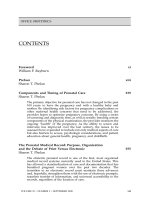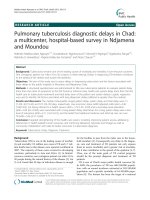Patient Safety in Obstetrics and Gynecology pot
Bạn đang xem bản rút gọn của tài liệu. Xem và tải ngay bản đầy đủ của tài liệu tại đây (99.48 KB, 6 trang )
Current Commentaries
Patient Safety in Obstetrics and Gynecology
An Agenda for the Future
Mark D. Pearlman,
MD
The effect of medical errors and un-
safe systems of care has had a pro-
found effect on the practice of ob-
stetrics and gynecology. From 1975 to
2000, medical malpractice costs for
obstetrician–gynecologists have risen
nearly four-fold higher than that of
other medical costs. In addition, it has
been estimated that defensive medi-
cine may cost society $80 billion per
year. Most importantly, many obste-
trician–gynecologists are frustrated
and seem to be abandoning the parts
of their practice they perceive to put
them at higher liability risk. This arti-
cle discusses other medical specialty
society efforts that have been suc-
cessful in addressing the area of pa-
tient safety. Efforts to better track
quality outcomes has been initiated
by the American College of Surgeons
through the National Surgical Quality
Improvement Project, and the Amer-
ican Society of Anesthesiologists has
demonstrated both dramatically im-
proved outcomes and reduced liabil-
ity costs through a concerted patient
safety effort. The author proposes
changes in four areas to specifically
address patient safety in obstetrics
and gynecology, including: the devel-
opment of reliable and reproducible
quality control measures (and a sys-
tem to track them); national closed
claim reviews to better understand
and address the most important
safety and liability areas for obstetri-
cian–gynecologists; work prospec-
tively with pharmaceutical and surgi-
cal device manufacturers to develop
innovative new products that would
increase the likelihood of safe out-
comes; and create a culture of safety
in obstetrics and gynecology by in-
corporating safety education into all
levels of training.
(Obstet Gynecol 2006;108:1266–71)
T
here is a great deal of angst
about the future of obstetrics
and gynecology. At or near the top
of the list of major concerns are
medical-legal issues and liability re-
form. At the intersection of medical
malpractice and liability reform lies
the topic of patient safety.
1
Al-
though caps on liability often dom-
inate the discussion of tort reform, I
believe there is a more fundamen-
tal issue—we have a moral obliga-
tion, irrespective of liability con-
cerns, to improve systems of health
care for women and to reduce un-
necessary morbidity.
On the one hand, there exist
regular multimillion dollar judg-
ments against obstetric–gynecol-
ogy physicians and hospitals, seem-
ingly capricious jury decisions, a
decreased interest in obstetrics and
gynecology by senior medical stu-
dents, early retirement among ob-
stetric–gynecology physicians, and
a strong sense of injustice in our
tort system. On the other hand,
although one can debate the exact
numbers, there is an extraordinar-
ily high frequency of patient inju-
ries due to errors. The annual inci-
dence of deaths related to medical
errors in our hospitals may be the
eighth leading cause of death in the
United States.
2
Since the Institute of Medicine
report, To Err Is Human, was pub-
lished in 1999,
2
much discussion
has been generated about fixing the
problem of error-related injuries in
health care. A variety of ap-
proaches have been suggested, and
some have already been partially
implemented: developing system-
atic methods for addressing error
reduction rather than blaming indi-
viduals, improving communication
among members of health care
teams, providing team training, im-
proving medical education about
error theory and prevention, and
instituting the 80-hour work week
for residents. Although many be-
lieve these efforts have merit, they
are relatively new initiatives and
have not yet demonstrated evi-
dence of any substantial reduction
in the frequency of injuries result-
ing from medical errors since
1999.
3
More recently, the Institute
of Medicine released a report sug-
gesting that 1.5 million preventable
adverse drug events occur each
See related article on page 1058.
From the Department of Obstetrics and Gynecology,
the University of Michigan Medical School, Ann
Arbor, Michigan.
An earlier version of this essay was presented as the
John Figgis Jewett Lecture of the Massachusetts
Medical Society on July 20, 2005.
Corresponding author: Dr. Mark D. Pearlman,
1500 E Medical Center Drive, L4000 Women’s
Hospital, Ann Arbor, MI 48109-0276; e-mail:
© 2006 by The American College of Obstetricians
and Gynecologists. Published by Lippincott Williams
& Wilkins.
ISSN: 0029-7844/06
1266 VOL. 108, NO. 5, NOVEMBER 2006 OBSTETRICS & GYNECOLOGY
year in the United States, many
resulting in permanent injury or
death (Aspden P, Wolcottt J, Boot-
man L, Cronenwett LR, editors.
Preventing medication errors.
Committee on Identifying and Pre-
venting Medication Errors Board
on Health Care Services. Institute
of Medicine of the National Acad-
emies, 2006. Available at: http://
newton.nap.edu/pdf/0309101476/
pdf_image/R1.pdf. Retrieved
August 1, 2006.). Recommenda-
tions included improved communi-
cation between patients and their
physicians regarding medication
use (eg, more thorough discussion
of adverse effects, contraindica-
tions, drug–drug interaction as well
as patients keeping better records
of their own medications). In addi-
tion, increased use of technology
such as electronic access to drug
information using personal digital
assistants, use of electronic pre-
scriptions to reduce legibility er-
rors, checking for allergies and
drug–drug interactions.
THE EFFECT OF DEFENSIVE
MEDICINE PRACTICES IN
OBSTETRICS AND
GYNECOLOGY
The sobering realities of liability
issues in our specialty are well doc-
umented. The average obstetri-
cian–gynecologist will be sued 2.64
times during his or her career.
Over the period 1975–2000, medi-
cal costs rose a remarkable 449%,
whereas during the same period
tort costs rose an astounding
1,642%.
4
Many obstetricians have
chosen to take an aggressive ap-
proach in their own practices to
manage this problem. Defensive
medicine is an interesting side ef-
fect of the medical tort system.
Some might even call it a growth
industry. Phillip Howard, a Wash-
ington attorney, one of the
founders of the advocacy group
“Common Good,” speaking at the
Annual Clinical Meeting of the
American College of Obstetricians
and Gynecologists (ACOG) in
2004, suggested that approximately
$80 billion are spent each year in
the United States on defensive
medical practices.
5
He argued that
this amount of money would be
more than enough to provide med-
ical care to the estimated 40 –50
million uninsured people each year
in the United States.
How prevalent is defensive
medicine in obstetrics and gynecol-
ogy? In 2003, Studdert, Brennan,
and Sage
6
conducted a large survey
of defensive medicine practices of
over 200 Pennsylvania obstetri-
cians and gynecologists, along with
600 physicians in other high-risk
specialties such as neurosurgery,
orthopedic surgery, radiology,
emergency medicine, and general
surgery. This study assessed the
behavior of high liability risk phy-
sicians in a high liability setting
state with somewhat disturbing re-
sults. This was a very seasoned
group of physicians: 96% of those
who responded had at least 10
years in practice. Using the defini-
tion of defensive medicine de-
scribed earlier, the authors found
that a remarkable 93% of these
physicians reported practicing de-
fensive medicine. Among obstetri-
cians and gynecologists, 54% stated
that they often ordered more tests
than medically necessary. Nearly
one third admitted to prescribing
more medication than was medi-
cally indicated. Two thirds stated
that they often referred patients to
other specialists in unnecessary cir-
cumstances to avoid the risk of
being sued. Obstetricians and gy-
necologists were also statistically
more likely to avoid certain high-
risk procedures or interventions
that their patients needed, and
nearly one half avoided caring al-
together for high-risk patients.
Equally worrisome was the find-
ing that 46% of survey respondents
had already stopped or were going to
stop all obstetrics in the next 2 years,
and another third will stop or soon
stop complex obstetric care. Nearly
40% of this group stated that they
will stop certain high-risk gyneco-
logic procedures they now perform.
Significantly, having been previously
sued did not affect the likelihood of
whether the respondents practiced
defensive medicine. Rather, two fac-
tors were the strongest predictors of
practicing defensively: 1) whether
the doctor felt he or she had ade-
quate insurance coverage; and 2)
doctors who described their insur-
ance premiums as being severely
burdensome t o their finances. Thus,
economic concerns seem to be more
likely to cause physicians to practice
defensively than simply the risk of
being sued.
Perhaps even more disturbing is
the avoidance of certain types of
high-risk patients. In the Pennsyl-
vania study, this practice was re-
ported more commonly by obstet-
ric–gynecologic physicians than by
those in other specialties. Avoiding
high-risk patients also has the great-
est potential for harm, particularly
in rural areas where alternative
sources of care may not be avail-
able. It can have a profoundly del-
eterious effect on essential health
services for women.
Irrespective of the positive or
negative effects on health care, the
To reduce errors and
improve outcomes in the
overall health of the
population, meaningful
quality outcome measures
must be used.
VOL. 108, NO. 5, NOVEMBER 2006 Pearlman Patient Safety in Obstetrics and Gynecology 1267
economic effects of defensive med-
icine practices are staggering—par-
ticularly with health care costs ap-
proaching more than 16% of the
gross domestic product.
7
It is also a
sign of an unhealthy system when
physicians are knowingly ordering
tests that they readily admit are not
likely to benefit their patients.
THE NEED FOR QUALITY
CONTROL MEASURES
Although many doctors are practic-
ing defensively and shunning high
liability areas of practice, what is
happening overall to the quality of
care in obstetrics and gynecology?
To reduce errors and improve out-
comes in the overall health of the
population, meaningful quality out-
come measures must be used.
Many outcome measures have
been developed for obstetrics and
gynecology. However, too often,
adopted measures are influenced
unduly by the variety of stakehold-
ers who participate in measures
development. Having sat on the
Joint Commission on Accreditation
of Healthcare Organizations
(JCAHO) Committee for the devel-
opment of quality measures in ob-
stetrics and gynecology for several
years, I have observed the process
and work product of this influential
group. At that time, the Committee
consisted of about 20 individuals,
including representatives of health
maintenance organizations, the
medical insurance industry, nurs-
ing, the American Medical Associ-
ation, JCAHO, and three obstetri-
cian–gynecologists. When candidate
measures were introduced, discus-
sion centered on the effect of the
proposed measures on outcomes,
the positive and negative effect of
various stakeholders, economic
considerations, ease of data collec-
tions, and so on. Not surprisingly,
the selected outcome measures
were not always evidence-based
measures intended to drive im-
proved patient care, or the measure
of quality of one institution com-
pared with another, or trends of
one institution over time. Rather,
the outcome measures were fre-
quently a consensus choice ulti-
mately selected by JCAHO to ad-
dress the concerns of its various
constituencies. One could strongly
argue that certain selected mea-
sures, such as cesarean delivery
rates or vaginal birth after cesarean
rates, fail to have any meaningful
effect on the health of pregnant
women and their infants.
As a specialty, obstetrics and
gynecology has a way to go to
effectively and systematically track
outcomes of our procedures, either
short or long term. As a result,
opportunities to identify best prac-
tices or, alternatively, identify and
correct substandard care are not
done consistently. Another spe-
cialty society, the American Col-
lege of Surgeons (ACS), adopted a
program initiated in the Depart-
ment of Veterans Affairs system to
collect and report risk-adjusted
event data for a variety of surgical
procedures. This methodology was
expanded 8 years ago to private
sector hospitals to determine
whether the methodology is appro-
priate in general surgical practice
in these hospitals. Over the past
several years, this tool has moved
from research to practice.
8
The ACS program is based on
data collected by a dedicated surgi-
cal nurse who assembles data on
133 variables, including preopera-
tive risk factors, intraoperative vari-
ables, and 30-day postoperative
mortality and morbidity outcomes
for patients undergoing major sur-
gical procedures in both inpatient
and outpatient settings. These data
are then analyzed centrally to en-
sure accuracy and consistency with
a random sampling methodology.
The data can then be reviewed in
semiannual reports, on-line re-
ports, and through ad hoc reports.
Finally, and most importantly, the
data are acted upon by comparison
of individual hospitals to national
benchmarks and best practices.
Best practices can then be adopted
with on-going data collection to
assure that outcomes have im-
proved. The ACS National Surgi-
cal Quality Improvement Project is
available to all private sector hos-
pitals that meet the minimum par-
ticipation requirements, complete a
hospital agreement, and pay an an-
nual fee of $35,000. Hospitals can
benefit from participating in the
ACS National Surgical Quality Im-
provement Project for many rea-
sons; most importantly the pro-
gram can contribute to the
reduction of surgical mortality and
morbidity. In October, 2002, the
Institute of Medicine named the
project the “best in the nation” for
measuring and reporting surgical
quality and outcomes.
9
HOW ONE MEDICAL
SPECIALTY OVERCAME ITS
MEDICAL LIABILITY
PROBLEMS
Much has been made of the effect
of the liability environment on the
increased cost of medicine and es-
calating malpractice insurance pre-
miums. Tort reform has been
touted by many as the cornerstone
of a solution for our current liability
crisis.
In the early 1980s one specialty
chose to address the liability crisis
with a different approach. In 1985,
the American Society of Anesthesi-
ologists (ASA) founded the Anes-
thesia Patient Safety Foundation.
Notably, this was 15 years before
the Institute of Medicine report was
published. The Foundation in-
cluded anesthesiologists, nurses, in-
surance companies representing
the malpractice industry, and even
some medical device companies
that made anesthesia equipment.
1268 Pearlman Patient Safety in Obstetrics and Gynecology OBSTETRICS & GYNECOLOGY
The Anesthesia Patient Safety
Foundation started the process by
systematically reviewing closed
claims, not a routine method in the
1980s; and through this procedure,
it was able to identify the major
causes of deaths in the operating
room. Most were related to failed
intubations, inadvertently discon-
nected ventilator tubing, and car-
bon monoxide poisoning.
9
Through
the work of this Foundation and
with the support of the ASA,
sweeping changes were put in
place. Pulse oximetry, which had
been used only sporadically in the
operating room before, became
part of the ASA standard of care.
Shortly thereafter, capnography
was also added as standard. These
changes were no small matter
when they were first introduced,
because pulse oximetry and cap-
nography equipment together cost
nearly $10,000. But hospitals
quickly purchased this equipment
because they recognized the in-
creased potential liability of not
doing so. Not surprisingly, with
widespread adoption, the cost of
these devices came down. Another
interesting finding in the closed
claims data were that many deaths
secondary to carbon monoxide
poisoning occurred on Mondays in
the operating room. Cases of CO
poisoning were very unusual in any
single hospital’s experience; and
only the large-scale, systematic re-
view identified this trend. Through
careful analysis, it was discovered
that carbon monoxide filters were
drying out over the weekend when
they were not used, rendering them
ineffective in extracting CO. A sim-
ple but broad-based policy of
changing filters on Monday morn-
ing virtually eliminated this
problem.
The Anesthesia Patient Safety
Foundation was also among the
first patient safety organizations to
develop simulation mannequins to
train all anesthesia residents in dif-
ficult intubation, emergency tra-
cheotomy, and the management of
many high-risk situations, all of
which problems had been identi-
fied through closed claims data.
The results of the combined ef-
forts of the Anesthesia Patient
Safety Foundation and the ASA
were dramatic. Anesthesia-related
intraoperative deaths plummeted
to 1 in every 200,000 –300,000 pro-
cedures, compared with about 1 in
5,000 operations in the early
1980s—more than a 98% reduction
in deaths. No one change created
this safer environment. The real
difference was an across-the-board
belief that the best approach to the
safety and liability problem was to
address the part of the problem
they could address—to understand
the cause of the deaths and to iden-
tify solutions to prevent them. And
most importantly, to implement
those solutions broadly.
The effect on malpractice premi-
ums and lawsuits against anesthesi-
ologists has been quite revealing as
well. In 2001, anesthesiology law-
suits accounted for 3.8% of all med-
ical malpractice compared with
more than twice that in 1972. Ad-
justed to 2005 dollars, payments on
awards have dropped from approx-
imately $300,000 in the 1970s to
$180,000 in the 1990s. Most inter-
estingly, inflation-adjusted mal-
practice premiums for anesthesiol-
ogists have declined from
approximately $32,600 in the early
1980s to $20,572 in 2002.
9
OBSTACLES TO PATIENT
SAFETY REFORM
In the June 2005 issue of Journal of
the American Medical Association, two
influential individuals in the patient
safety field, Lucian Leape and
Donald Berwick, outlined the (too)
slow progress in patient safety ef-
forts since the Institute of Medicine
report was released in 1999.
3
They
blamed in large part the so-called
culture of medicine—a culture that
is deeply rooted, both by custom
and training, in autonomous indi-
vidual performance and a commit-
ment to progress through research.
These traits have resulted in pro-
found advances in biomedical sci-
ence and delivered unprecedented
cures to millions of people. But the
tenacious commitment to individ-
ual, professional autonomy creates
a barrier to progress in the patient
safety arena. Creating cultures of
safety requires major changes in
behavior, changes that we as pro-
fessionals often perceive as threats
to our authority and autonomy.
Given this challenge to fundamen-
tal change, combined with the in-
troduction of a nonblaming, sys-
tems approach to errors, which is
quite foreign to the training of most
practitioners, it is not surprising
that progress has been slow. Other
problems that create huge disincen-
tives to move forward include the
lack of robust and accurate mea-
sures of quality in obstetrics and
gynecology and a reimbursement
system that does not recognize safe
practices. Despite these barriers,
most physicians, nurses, pharma-
cists, and other health care provid-
ers are actively engaged in the ef-
fort to improve our patient care
and provide safer environments in
our delivery suites, our operating
rooms, and our offices.
There are tools available to pro-
vide safer care. Computerized phy-
sician order entry programs are
eliminating many, but not all, med-
ication errors. Electronic medical
records are increasingly being used
throughout the United States to as-
sure access to critical medical infor-
mation. Meaningful quality mea-
sures and safe practices, such as
reducing ventilator-related pneu-
monias, catheter-related sepsis, and
medication errors, are gradually
being implemented. Perhaps most
VOL. 108, NO. 5, NOVEMBER 2006 Pearlman Patient Safety in Obstetrics and Gynecology 1269
important, a change in the culture
of shared effort and responsibility
between physicians, nurses, phar-
macists, and other health profes-
sionals is slowly taking place. At
my institution (University of Mich-
igan), clinical pharmacists regularly
participate in rounds on a wide
variety of clinical services with
physicians, assisting with medica-
tion selection, educating students,
house officers, and faculty, but
most importantly, catching poten-
tial medication errors before they
reach the patient. The experience
has been uniformly positive, and
expansion throughout the inpatient
arena is moving forward.
Also, experimental and pilot
programs are being investigated
with Centers for Medicare and
Medicaid Services and other pay-
ers to evaluate the effectiveness of
incentive pay for outstanding safe
performance, and the whole “pay
for performance” idea is gaining
momentum and currently being
implemented in parts of the United
States. The Accreditation Council
for Graduate Medical Education
has introduced practice-based
learning and systems-based prac-
tices into the evaluation process of
all approved training programs, as
well as implementing the 80-hour
work week. And the unethical
practice of not disclosing injuries to
patients is rapidly disappearing
from our landscape.
CHANGES IN OBSTETRICS–
GYNECOLOGY THAT CAN
IMPROVE PATIENT SAFETY: A
CALL TO ACTION
We cannot reasonably expect oth-
ers to determine the best and safest
practices in obstetrics–gynecology.
We have a moral imperative as a
specialty to fully engage in the
identification of our own best prac-
tices, to advance safety research in
obstetrics and gynecology, and to
implement broadly those practices
which are best. This is no simple
task. It will require time, commit-
ment, resources, and a radical re-
structuring of our view of physician
autonomy. Working in teams and
sharing responsibility for patient
well-being are not traditional be-
haviors of physicians, and we must
learn from our mistakes. These be-
havior changes, however difficult,
will benefit our patients and us.
We are at a crossroads in obstet-
rics and gynecology. Some have
invested in tort reform as the strat-
egy to solve our problems, but I do
not believe that tort reform alone
will change outcomes. It will not
change or improve the care we
provide to our patients. However,
we can control our own destiny by
actively pursuing aggressive
changes in how we approach safe
care.
To initiate these changes, I pro-
pose the following steps:
1. Develop reliable and repro-
ducible quality control mea-
sures for obstetrics and gyne-
cology that go beyond
measures such as cesarean de-
livery or vaginal birth after ce-
sarean rates. As an example,
the Weighted Adverse Out-
come Index described by
Mann et al (Mann S, Pratt S,
Gluck P, et al. Assessing qual-
ity in obstetrical care: develop-
ment of standardized mea-
sures. Jt Comm J Qual Patient
Saf 2006;32 [in press]) offers a
useful model for how to estab-
lish such valid measures, al-
though further testing and val-
idation needs to be done on a
more comprehensive basis be-
fore it can be accepted as a
standard. Encouraging in-
creased funding for continued
research and testing in this im-
portant area should be a high
priority for ACOG and other
stakeholders.
2. Support the establishment of
closed claim reviews on a na-
tionwide basis and incorporate
the results into practice bulle-
tins. Although closed claims re-
views have been performed in
obstetric and gynecologic set-
tings, they most often have
been undertaken regionally.
As a result, the lessons learned
may reflect local practice pat-
terns, but more likely, they are
lost due to a perceived lack of
applicability beyond those pro-
vincial borders. To truly trans-
form the quality of care in ob-
stetrics and gynecology and
improve patient safety in a
meaningful way, the College
should engage fully in this ef-
fort, not only by simply evalu-
ating and analyzing closed
cases but also by incorporating
the important lessons learned
into practice bulletins. This
step would not only provide a
safer harbor for good practice,
but it could potentially trans-
form practice to make it safer.
3. Create partnerships with the
pharmaceutical and medical
devices industries to develop
safer drugs and equipment and
to provide training for health
care professionals in the safe
use of complex new equipment
(eg, robotics). Our national so-
cieties should partner with
companies to produce simula-
tion training modules and cre-
dentialing procedures that
would require physicians to be
tested in the safe use of sophis-
ticated devices before being
granted privileges to use such
technologies in the operating
room on patients.
4. Incorporate patient safety edu-
cation into all levels of training
as a requirement for initial and
continued board certification—
from undergraduate medical
education, through residency
1270 Pearlman Patient Safety in Obstetrics and Gynecology OBSTETRICS & GYNECOLOGY
and other postgraduate train-
ing programs, and continuing
with a demonstration of both
the understanding and practice
of safest medical practice sys-
tems. As one important ele-
ment of this proposal, the Col-
lege should focus on training
department chairpersons (aca-
demic and nonacademic) to
support and disseminate ac-
cepted methods in patient
safety, such as team training,
appropriate antibiotic and deep
vein thrombosis prophylaxis
before surgery, and root cause
analysis methodology, among
others. The American Board of
Obstetrics and Gynecology
can also assist in assuring that
patient safety principles are in-
tegrated into practices by em-
phasizing these in board certi-
fication examinations and by
selecting relevant patient safe-
ty-related articles in the ABC
program
Changes such as I am proposing
will help shape our efforts in pa-
tient safety over the next 3 to 5
years and beyond. We must work
together to provide a mechanism
for research into safer methods of
practice and to engage industry
with a mission of improved safety
for the procedures we perform.
The ACS is participating in the
National Surgical Quality Im-
provement Project, which carefully
tracks important outcomes from
common operations. Our College
should join this effort as well, so
that we can learn from best prac-
tices and employ them in our own
patient care. The American Col-
lege of Obstetricians and Gynecol-
ogists can assist us by providing the
foundation upon which we can im-
plement changes in practice. These
changes will require work and
money and time—and the com-
bined efforts of all of us.
REFERENCES
1. Clinton HR, Obama B. Making patient
safety the centerpiece of medical liabil-
ity reform. N Engl J Med 2006;354:
2205–8.
2. Kohn LT, Corrigan JM, Donaldson
MS, editors. To err is human: building a
safer health system. Committee on
Quality of Health Care in America.
Institute of Medicine. Washington
(DC): National Academy Press; 1999.
3. Leape LL, Berwick DM. Five years
after To Err Is Human: what have we
learned? JAMA 2005;293:2384–90.
4. Black BS, Silver CM, Hyman DA, Sage
WM. Stability, not crisis: medical mal-
practice claim outcomes in Texas,
1988-2002. University of Texas Law &
Economics Research Paper No. 30;
Columbia Law & Economics Research
Paper No. 270; University of Illinois
Law & Economics Research Paper No.
LE05-002. Social Science Research
Network 2005. Available at: http://
ssrn.com/abstractϭ678601. Retrieved
August 10, 2000.
5. Howard PK. Is the medical justice sys-
tem broken? Obstet Gynecol 2003;102:
446–9.
6. Studdert DM, Mello MM, Sage WM,
DesRoches CM, Peugh J, Zapert K, et
al. Defensive medicine among high-risk
specialist physicians in a volatile mal-
practice environment. JAMA 2005;293:
2609–17.
7. Health insurance cost: facts on the cost
of health care. National Coalition on
Health Care. Washington (DC), 2004.
Available at: http:///www.nchc.org/
facts/cost.shtml. Retrieved May 29,
2006.
8. About ACS NSQIP: History of the
ACS NSQIP. American College of Sur-
geons, National Surgical Quality
Improvement Program, 2005. Avail-
able at: />about_history.asp. Retrieved May 17,
2006.
9. Anesthesiologists and patient safety.
Wall Street Journal (Eastern edition).
July 19, 2005. p A15.
VOL. 108, NO. 5, NOVEMBER 2006 Pearlman Patient Safety in Obstetrics and Gynecology 1271









